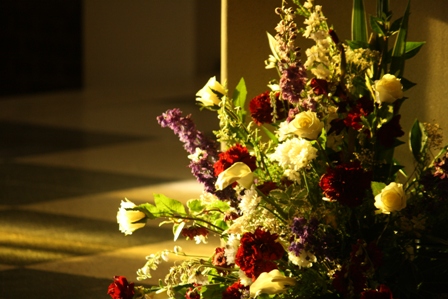The History of the Ministry.
Although perhaps appearing under different titles, ministers of the liturgical environment have been around since Christians first started to gather for worship – since someone decided to create something of beauty for the place where the community gathered. Throughout the centuries man and women of all nationalities have, whether through permanent works of art in fresco, mosaic, pictorial representation or sculpture, or temporary arrangements of flowers and other objects, tried to enhance our worship through their skill.
This has been especially true since the reforms of the Second Vatican Council. The primary role of the church building has always been to give the community somewhere to gather to celebrate the Mass. Immediately prior to the Second Vatican Council the focus was very much on private devotion – the priest celebrated the Mass, the congregation sat in the pews engrossed in their own devotions and rarely went to Holy Communion. Following the Council the focus moved back to public worship – the people were again full and active participants in the mysteries being celebrated, and they needed visual aids to draw their minds into that active participation.
The Nature of the Ministry.
“In order to communicate the message entrusted to us by Christ, the Church needs art. Art must make perceptible, and as far as possible attractive, the world of the spirit, of the invisible, of God. It must therefore translate into meaningful terms that which is in itself ineffable. Art has a unique capacity to take one or another facet of the message and translate it into colours, shapes, and sounds that nourish the intuition of those who look or listen. It does so without emptying the message itself of its transcendent value and aura of mystery.”
Pope John Paul II, Letter to Artists 12.
“The church building should be beautiful. The external and internal structure of the church building should be expressive of the dignified beauty of God’s holy people who gather there and of the sacred rites they celebrate. Liturgical art and architecture reflect and announce the presence of God who calls the community to worship and invite believers to raise their minds and hearts to the One who is the source of all beauty and truth. Art and architecture that draws more attention to its own shape, form, texture or colour than to the sacred realities it seeks to disclose is unworthy of the church building.”
Built of Living Stones, 44.
I am interested in this ministry - what will it involve me doing?
God is beauty. God deserves beauty. As a minister of the liturgical environment you will be part of the team responsible for making that beauty and through it enhancing the worship of the community. As you do this you will deepen and enhance your own relationship with God as you take things of beauty that He has created to create mood and atmosphere within the blank canvas that is the church building. This will be done through arrangements of flowers but also through other objects such as banners used to reflect and emphasise the changing feasts and seasons running through the whole spectrum from the austerity of Lent through to the exuberance of Easter and Christmas. As a member of a team you will always have the support and assistance of its other members. If you do not feel that you have the necessary artistic talents to assist with flower arranging the cleaning of a public building like a church is a neverending task and our team of church cleaners is always in need of assistance.
Further reading:
Mary Patricia Storms and Paul Turner (2009) - Guide for Ministers of the Liturgical Environment. [The Liturgical Ministry Series]. Chicago. Liturgy Training Publications.
Catholic Bishops' Conference of England and Wales (2002) - General Instruction of the Roman Missal. London. Catholic Truth Society.
Text from the Liturgy Office website (large PDF file)
Catholic Bishops' Conference of England and Wales (2005) - Celebrating the Mass; a pastoral introduction. London. Catholic Truth Society.
Text from the Liturgy Office Website (large PDF file).
Peter J.Elliott (2005) - Ceremonies of the Modern Roman Rite; the Eucharist and the Liturgy of the Hours. Second edition. San Francisco. Ignatius Press.
Mark G.Boyer (2004) - The Liturgical Environment; What the Documents Say. Second Edition. Collegeville, Minnesota. Liturgical Press.
